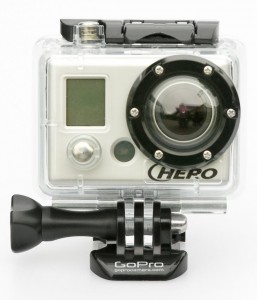 In 2009, the small company Woodman Labs shook up the wearable camera market by introducing the GoPro HD Hero. Prior to its introduction, affordable wearable cameras had only been available shooting in standard definition, and this, coupled with the relatively narrow-angle lens they used, meant the footage tended to be somewhat underwhelming – low resolution, somewhat murky and often very shaky.
In 2009, the small company Woodman Labs shook up the wearable camera market by introducing the GoPro HD Hero. Prior to its introduction, affordable wearable cameras had only been available shooting in standard definition, and this, coupled with the relatively narrow-angle lens they used, meant the footage tended to be somewhat underwhelming – low resolution, somewhat murky and often very shaky.
The GoPro changed all that. It shoots in HD – either full HD at 30 fps, or 720p at a creamy 60fps. Coupled with that, its 170-degree wide angle lens means that almost everything in front of the camera is captured. The combination of the high resolution and the super wide angle is stunning. The footage is crisp and sharp and – because the wide angle has the effect of nullifying camera shake – very smooth. The GoPro has become the defacto extreme sports helmet cam, being used for base jumps, wing suit flying, big mountain skiing… Whenever you see high quality POV footage, the chances are it is from a GoPro.
While the 170 degree lens means that the edges of the frame are quite distorted (with trees bending in towards the centre and the horizon curving up) the central area of the frame is relatively unaffected. In any event, after watching for only a few moments, the brain seems to accept the distorted perspective as normal and just focus on the action.
The GoPro is sold with various mounting kits, and others can be purchased for it. They are all based on a screw-in clamp that affixes to the bottom of the waterproof case, and allows the horizontal angle of the camera to be set. The basic helmet strap works well, and can be adjusted to a wide range of fits. It’s necessary to experiment a bit with the best angle to use mount the camera relative to the ground (top tip – you probably look down more than you think when skiing!) but again, the wide angle means that if it’s pointing in roughly the right direction you will get usable footage.
We’ve also had a lot of success in using one of the other supplied straps to mount the GoPro on the end of a ski pole, which can then be held away from the skier as they ski along for a unique perspective (plenty of examples in this video from Aspen). A chest mount harness is also available from GoPro, and this works well for skier-POV footage – the lower position means you see more of the skier’s arms and skis, and there is not the issue of a great shot being disrupted when the skier looks around to see where their buddies are. Again, examples of this type of footage can be seen in the video below:
The GoPro camera itself is contained within a waterproof housing, and in order to charge it or change the SD card, you have to open the rear door and take the camera out. There is no need to open it on the slopes though, as the case has two push-through buttons to control the camera. One button (on the front) turns the camera on or off and cycles through the menu; the other (on the top) is the shutter button. It’s fair to say that the original GoPro does not have a great menu interface – the settings are indicated by a series of cryptic codes and numbers, and you need to refer to the manual to get it set up. In fairness though, once you’ve got the correct setting dialled in (which for us is nearly always the 720p at 60fps), all that is needed is to turn the camera on and start it rolling.
GoPro have recently released the HD Hero 2. While the form of the camera is unchanged, thus addresses many of the criticisms about the menu system, which a much clearer display setup. The new GoPro also boasts a lens that is claimed to be 2x sharper, a higher megapixel still shot ability, and various other improvements. However, while more options for video resolution are included, the main mode we find ourselves using (720p at 60fps) remains effectively unchanged.
As a consequence of the release of the GoPro 2, the original GoPro is now being sold at a hefty discount. If money is no object then the clearer menu and new features of the GP2 make it worth the extra cash. But the original GoPro is now looking like a bit of a bargain. Find it here on Amazon

